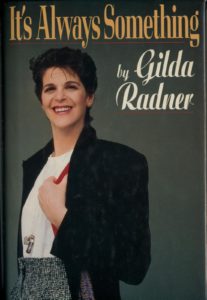Love, Gilda, a CNN documentary by Lisa D’Appolito; to open Friday, September 21, at the Landmark Theatre in San Diego’s Kensington neighborhood.
By Donald H. Harrison

 SAN DIEGO – While growing up, Gilda Radner was teased unmercifully about being overweight. Her mother even put her on diet pills when she 10 years old. Knowing that school children would call her fat, she often would beat them to the punch by making a joke about herself that made them laugh. Comedy, she learned, is “hitting on the truth before the other guy thinks of it.”
SAN DIEGO – While growing up, Gilda Radner was teased unmercifully about being overweight. Her mother even put her on diet pills when she 10 years old. Knowing that school children would call her fat, she often would beat them to the punch by making a joke about herself that made them laugh. Comedy, she learned, is “hitting on the truth before the other guy thinks of it.”
Although she got laughs and was able to hone her humor in high school productions in Toronto, Canada, followed by semi-professional gigs on stage and on radio, Radner never stopped feeling insecure about her weight. Not known to the general public, she developed an eating disorder, in essence starving herself, so that at one point she dropped down to 100 pounds.
However deep her personal insecurities and depression may have been, Radner transformed herself into a confident comedian whenever she was on stage. Working with such future television personalities as band leader Paul Shaffer and comedian Martin Short, she became part of an improvisational troupe known as The Second City, where she met another future star, Dan Akroyd. Later, they would be recruited by John Belushi to participate in National Lampoon Radio Hour, in which she worked with another comedic star, Harold Ramis. All this led to Lorne Michaels, creator of television’s Saturday Night Live, to recruit her in 1975 to be the very first person hired for the cast. “She was enormously likeable,” explained Michaels, “so I started with her.”
Radner, Laraine Newman, and Jane Curtin were the regular female performers in the original Saturday night cast. I remember Akroyd, Chevy Chase, John Belushi, and Garrett Morris as the standout male comedians.
The documentary combines interviews, old TV footage, home movies, and Radner’s letters to her family with selections from her diary, read by such SNL successors and guest stars as Amy Poehler, Maya Rudolph, Cecily Strong, Bill Hader and Melissa McCarthy. We also get to see again some of the wonderful characters that Radner created on SNL, among them the opinionated, although not always well-informed Rosanne Roseannadanna, a characterization that won her an Emmy, and Emily Litella, the latter of whom was a little old lady based upon Radner’s own childhood nanny.
The success of SNL turned Radner et al into instantly recognized stars, a fact that Radner on a personal level had difficulty assimilating. How was it that so many people admired her on stage, but in her personal life, she could not find some wonderful guy to really love her. She admitted that she cringed when she watched the movie Ghostbusters, because it starred three of her ex-boyfriends: Bill Murray, Harold Ramis, and Dan Akroyd.
When Belushi and Akroyd left SNL to do the movie Blues Brothers, Radner was called upon to do more and more SNL skits, and, according to the documentary, the pressure on her was enormous. That was when her eating disorder became most pronounced. In June 1978, after three years of SNL, according to the documentary, “she weighted 104 and she thought she was fat.” Soon thereafter she left the show.
Next, she performed in a one-woman show on Broadway, and although audience reaction to her shenanigans was overwhelmingly favorable, she decided that venue was not for her. “I didn’t want to be Gilda Radner, a solo performer … I was lonesome for myself.”
Although Radner had no lack of dates, she had only two serious relationships. At one point she became engaged to G. E. Smith, a guitarist for Hall & Oates, but that was later broken off. The more important and lasting relationship was with fellow Jewish comedian Gene Wilder, who already had made such movies as Willy Wonka & the Chocolate Factory, and Blazing Saddles, and was about to team up with director Mel Brooks to make Young Frankenstein.
Having been married twice before, Wilder was cautious about marriage, but Radner overcame his reluctance in what she described as a 2 ½ year campaign to become his wife. From all accounts buttressed by the documentary footage, they and their dog “Miss Sparkles” were incredibly happy together, but the fabled relationship was not to last. Their first tragedy was when Radner miscarried a child they both so much wanted. The second tragedy was the discovery that she had ovarian cancer.
Although Radner battled the disease into remission temporarily, eventually it got the best of her – but not before she sang an X-rated song about cancer, and joked about her disease on Garry Shandling television show, her first appearance on television after a prolonged absence. Their onstage repartee started with Shandling asking her what she had been doing lately. “I had cancer,” she replied bluntly. “What did you have?” Shandling replied he hadn’t done anything in particular, except to make a series of bad career moves.
Radner died in 1989, a legendary and beloved comedian, leaving behind the manuscript of a posthumously published memoir, It’s Alwasys Something. I hope that the documentary Love, Gilda (opening September 21 at the Landmark Theatre) will introduce another generation to her zany comedy, and drive home the lesson that no matter what your personal problems may be, you can face them with class – as Gilda Radner most assuredly did.
*
Harrison is editor of San Diego Jewish World. He may be contacted via donald.harrison@sdjewishworld.com